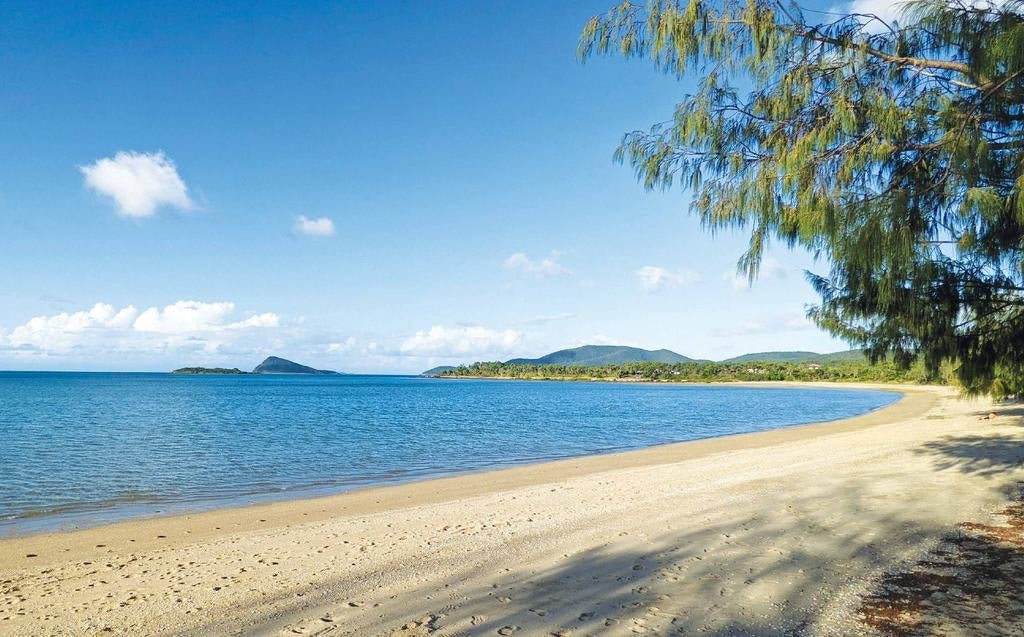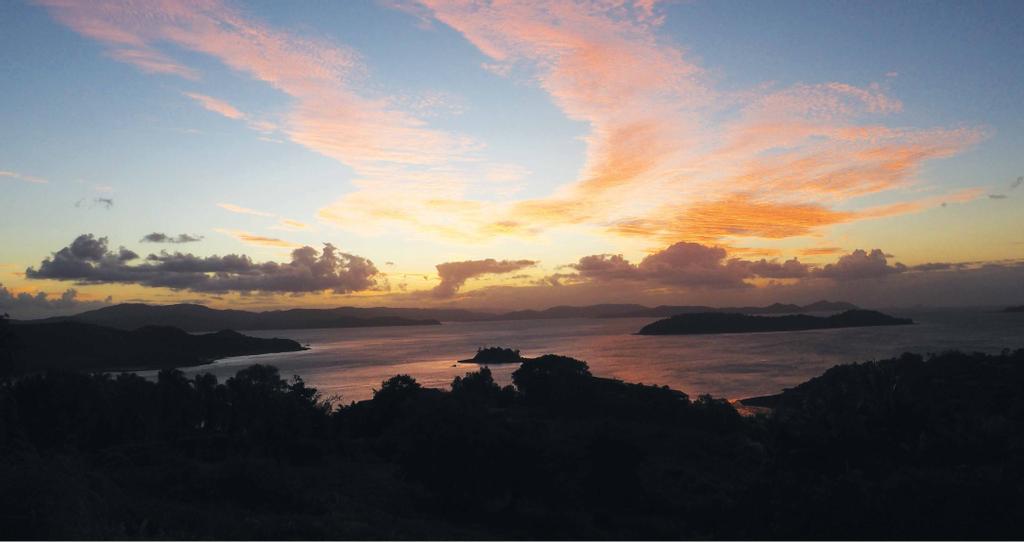Every Day is Sunday

Queensland’s Whitsunday Coast is a tropical destination with dozens of islands and access to the coral playgrounds of the World Heritage-listed Great Barrier Reef. With warm winter weather, it’s a bucket-list destination for caravanning nomads on their annual escape out of dreary winter climates.
But you need time if you’re a traveller from the southern states. Even from Brisbane, it’s an 1100km drive, making a weeklong adventure towing a van from Melbourne. Luckily there is plenty to see along the way, and your choice of inland or the much longer coastal tracks adds variety to the return trip.
When James Cook named the opening through the island group the Whitsunday Passage on 9 June 1770, he did so in the mistaken belief it was on the Christian holiday of Whit Sunday. As it turned out, he had crossed the dateline, and it was actually Whit Monday. Don’t be too hard on Cook though — if you put in enough island time, poor James won’t be the last one to not know or care what day it is.
As he passed through the islands, Cook encountered the Ngaro people, who had been living and hunting in the region for thousands of years. Evidence of their maritime skills can be seen in a quote from Cook’s journal.
“On a sandy beach, we saw two people and a canoe with an outrigger that appeared to be both larger and differently built to any we have seen upon the coast.”
The Ngaro and Mia people from the mainland have a solid connection to the land and manage the area with the Whitsunday National Park. Much archaeological evidence still exists, and an interpretive site at Nara Inlet on Hook Island preserves rock art and middens in a cave where the occupation has been dated back 9,000 years.
Better known as the Whitsundays, the archipelago was formed when 74 peaks of a mountain range submerged after polar ice caps melted and sea levels rose more than 6000 years ago. European settlement was based on agriculture both on the mainland and on some of the larger islands. By 1920, the region’s beauty and climate lured tourists, and the first fledgling holiday destination was established on Lindeman Island.
Fine coral and silica sediment suspended in the water scatters in the sunlight for the memorable and picture-perfect blue and stands of eucalypts and hoop pine contrasting against the aquamarine ocean add to the natural beauty of the towering volcanic hills.
As far back as the 1930s, as agriculture on the islands declined, leases were converted to National Parks. These days, more than 96 per cent of the 30,000ha is protected in the park system.
By 1936 tourism had grown to the extent that the township of Airley was established as a jumping-off point to the Whitsundays and the Reef. In pre-COVID days the town was a thriving regional centre with half a million visitors each year from across the globe — however, it should be noted that 75 per cent of holidaymakers are Australian residents, showing how much we love a home-grown tropical escape.
Combined with neighbouring localities of Cannonvale, Jubilee Pocket, and Shute Harbour, the permanent population numbers around 4500. Nearby Proserpine has some 3500 residents in its mainly rural economy.
When we visited in April 2021, things were much more laidback, but there was still plenty to see and do for anyone able to travel. Local shopping includes a well-stocked supermarket and a street full of chill clothes stores. Restaurants and cafes abound, with plenty of outdoor venues to judge the passing parade.
GETTING THERE
If you have driven from the south along the Bruce Highway, it’s a relief finally turning off at Proserpine to the coast. The Shute Harbour Road takes you past cane fields between steep mountains and finally through the built-up areas of Cannonvale, where big box stores offer all the modern traveller’s needs. The first sight of the ocean highlights the sheltered waters of Pioneer Bay and the Coral Sea Marina, where hundreds of yachts wait in the sparkling blue water.
You have your choice of four caravan parks in town and a cheaper council bush camp at Lake Proserpine, about an hour’s drive away.
Numerous companies offer day tours to the Reef and islands. A wide variety of resorts welcome visitors and day-trippers. For a taste of a more solitary ocean life, hire fleets of sail and powerboats let you explore at your own pace.
While island hopping and diving on the Reef mean you need to park the van for a while, there is plenty to do and see on the mainland. The regions caravan parks are among the best anywhere.
PARK THE VAN
Seen from the road, the Adventure Whitsunday Caravan Park looks like any of the many you will find on the drive along the coast. But when marketing manager Tanya Cran showed us around, we soon saw how much the McKinnon family has achieved on the 26ha site over the past 28 years. 168 powered caravan sites are beautifully laid out with plenty of shrubs and palms for privacy and lots of activities to entertain. If you need a break from the van, there are 73 self-contained cabins, some with room for extended families.
As well as a coffee van and cafe, you will find a giant water park with 13 slides and a pool that’s heated in winter, a tennis court, poolside massage area, and an outdoor cinema for movies under the stars. In addition, kids are covered with mini-golf, animal park, craft club, two jumping pillows and organised activities.
The park is popular even with Airlie Beach locals who book in for the weekend. Tanya told us of guests who stay for a week without leaving the park and have to book another holiday to see the rest of the Whitsundays.
CHOOSE YOUR PACE
Options for getting on the water and over to the islands are numerous. Still, we liked the look of the varied offering from Red Cat Adventures. They have fast 32- or 38-seater catamarans with day tours to the islands for snorkelling and taking in the best sites. Popular tours include Whitehaven Beach with its whiter than white sand and one of the most photographed views in Australia from Hill Inlet.
For a slower pace, take the sailing cruise on the 40ft cat, Tongara to Langford Sandbar and the colourful fringing reefs for snorkelling before returning as the sun sets over the mainland.

Sunset puts a new spin on the region
The Whitsundays are Australia’s most popular cruising ground. Steady winds and safe anchorages allow even novice sailors to take the helm, and a week on the water will let you see much of what the area has to offer. Whitsunday Escape has sailing cats and monohulls and a selection of motoryachts. They will teach you the basics of sailing, but it’s best if someone on board has had some experience with boating. They will guide you on the best and safest places to anchor and swim and monitor your journey with regular radio contact.
The major tourist operator is Cruise Whitsunday, and their fleet of vessels covers all bases. Their ferry service runs every couple of hours during the day and links the Port of Airlie with Hamilton and Daydream Islands. In addition, they run day trips to Hamilton Island Resort and combination tours that take in Hamilton Island and Whitehaven Beach.
ISLAND LIFE
Accommodation on the Islands ranges from relatively budget to ultra swanky. Scamper Charters can deliver you on their 18-seat barge to 13 national park campsites at Hook, Whitsunday, and South Molle — and they even hire out camping equipment. Prices range from $65 to $160pp return. Camping fees are $6.85pp a night or $27.40 for families, but you need to book well in advance for both the boat and campsite.
Hamilton Island is the largest and most developed resort, so it’s busier than the smaller resorts and is more expensive. Expect a studio room from $250 a night plus transfers.
If the confines of the van are wearing you down, then at the upper end of the price scale, why not book into the Windward Pavilion at Qualia Resort on Hamilton Island? Well, the price mightn’t be for everyone. But, if it doesn’t frighten you, then luxuriate in the north-facing unit with panoramic views to the horizon and a private plunge pool from $2200 a night.
A NIGHT ON THE REEF
My choice for an offshore adventure would be an overnight trip to the outer Reef with Cruise Whitsundays. Located 39nm (72km) from Airlie Beach, stay in an underwater suite at Hardy Reef on a roomy, permanently moored pontoon. These Reef World Rooms have plate glass windows with views of the coral and the ever-changing fish life. The cost is $1598 a couple and includes the 3hr voyage, all meals and drinks and a guided snorkelling tour. Tours depart at 8am each day and return at 6pm the following day.
THE MAINLAND
Like most places in the tropics, you need to be aware of seasonal stingers and other mighty creatures. But, you will find a safe place to swim right in the middle of town at the Airlie Beach Lagoon, where there’s plenty of room and lots of shade to relax.
It’s an easy drive into the National Park area, and there is any number of walking and mountain biking tracks. In addition, Red Cat Charters runs bus tours to Cedar Falls with its freshwater pool and rainforest bushwalks.
Take a 40-minute drive on sealed roads north of Airley to the laid back coastal village of Dingo Beach on Cape Gloucester. The pub has a yesteryear appeal, and the idyllic,casuarina-lined beach make the trip worthwhile. But you can also hire boats for fishing or snorkelling on the nearby islands and reefs. Dingo Beach Escape has a selection of outboard dinghies and kayaks, giving you access to the fishing and diving spots at Blackcurrant and Manta Ray Islands.
WHEN TO VISIT
The tropical north comes alive in winter when endless blue skies greet holidaymakers for weeks on end. Summer is the wet season, meaning crowds are smaller, but the high humidity isn’t for everyone. Winter temperatures should see 22 degrees during the day, with water temperature around 25 degrees all year round. Peak sailing season is June to October, and the slight winds also make for smooth cruising to the Reef on charter boats.
INDIGENOUS PEOPLES







